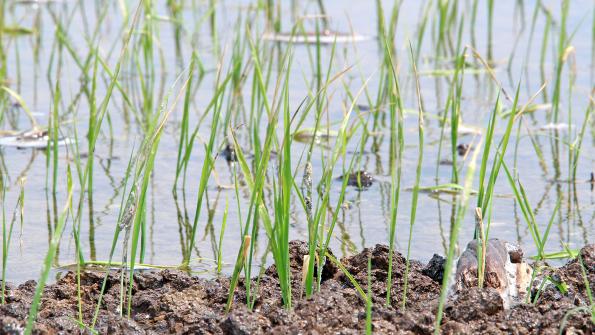May 27, 2015

We just received our every-other-day flood at Practical Weed Consultants. A lot of farmers and consultants have reached their frustration limit. Most of my calls right now are from people just wanting somebody to listen while they vent their frustration.
That is fine. I understand. A lot of farmers I talk to are farming scared this year anyway due to the poor price outlook, and now we have to put up with this. This too shall pass, and all we can do is ride it out. My hat is off to anybody willing to be a farmer!
Those who have been able to overlay residuals in rice are generally in pretty good shape from a weed control standpoint. Some residuals are breaking early, and that is a reason it is important to overlay them. In a lot of areas there is a lot of “sick rice.” Where weeds are emerging, it has been difficult to find treatments that would control the weeds and not further injure the sick rice and that could be sprayed due to emerged crops.
I knew the calls would be coming along the lines of, “I need to spray my rice and I have milo to the north, milo to the south, soybeans to the east and corn to the west. What can I use?” I think I am pretty good at pulling rabbits out of the hat but not that good.
I have been recommending a lot of Bolero or RiceBeax in mixtures to shore up sprangletop control. Sprangletop is a saturated-soil germinator. More and more calls are Ricestar HT questions due to emerged soybeans around a lot of fields along with a lot of emerged sprangletop.
When I get calls about larger barnyardgrass, I switch the recommendations to Regiment or Regiment plus Facet where I can. I consider it the best postemergence barnyardgrass herbicide, but it can be frustrating to get applied due to the crop mix in some cases.
There are a lot of choices for herbicides that might work on the weeds, but it often boils down to what can be applied. The main thing is to do something while the grass is still small and make sure there is a residual herbicide in the tank.
It seems like I get more questions on crabgrass in rice each year. The best postemergence crabgrass herbicide is Ricestar HT, but it will not be 100 percent on larger crabgrass. It will usually rot the growing points, and if you can cover it up with water it will go away. Unfortunately crabgrass usually is a problem only on soils that won’t hold water or where water is short.
Where fall panicum is a problem, Clincher is the postemergence herbicide of choice.
In soybeans it seems to be a mixed bag as to how well residual herbicides have held up with all the rain. I have been in several fields where farmers have not been able to apply second residual, and there is a carpet of tiny pigweeds emerging. Those have to be sprayed soon in spite of the weather.
Flexstar or Prefix might be the treatment of choice in Roundup Ready soybeand or Liberty the treatment of choice in LibertyLink soybeans. However, if the ground won’t dry, UltraBlazer applied by air is a good choice. Blazer is labeled in rice and peanuts and both corn and grain sorghum have reasonable tolerance if you don’t get carried away.
Hopefully we will not have a bunch of big pigweeds to deal with, but if it keeps raining we will. Whether you are using Liberty in LibertyLink soybeans or the Flexstar-UltraBlazer treatments in Roundup Ready or conventional soybeans, a repeat treatment in about seven days after the first is the key on larger weeds.
About the Author(s)
You May Also Like




